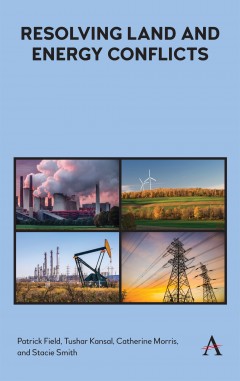Resolving Land and Energy Conflicts
By Patrick Field
Tushar Kansal
Catherine Morris
Stacie Smith
Strategies for Sustainable Development Series Anthem Environment and Sustainability Initiative
Other Formats Available:
- About This Book
- Reviews
- Author Information
- Series
- Table of Contents
- Links
- Podcasts
About This Book
Unlike almost any other kind of land use – from dumps to houses to factories – state and sometimes even the federal government actively preempt local decision-making regarding the siting of energy extraction and production. The Consensus Building Institute looked at conflicts over land and found in the last ten years that rapid advances in technology in both renewables (primarily wind and solar) and gas and oil extraction have created a host of new and intensive land-use conflicts across the United States. Wind turbines, for instance, seemingly clean, lean and ‘sustainable’, have stirred intense conflicts among abutters, developers, and communities. A resurgence in US gas and oil production via hydraulic fracturing technology, resulting in lower costs, more domestic production and less dependence on unstable supplies of foreign oil, has created statewide bans, protest films and national debate about ‘fracking’.
‘Resolving Land and Energy Conflicts’ seeks to develop a view of energy in the landscape across gas and oil, wind, transmission and nuclear waste disposal. The first three create conflict because of rapid or the need for rapid development or expansion. Each of these energy types or facilities are generally considered a public good and expansion promises future benefit, but they have concentrated impacts that can cause localized adverse effects and controversy. The last, nuclear waste, creates conflict because it is a public ‘bad’ and a legacy of choices made decades ago for benefit that, in some ways, has already been delivered (affordable electricity through nuclear power coupled with a reliable base load generating source).
The authors are particularly interested in the conflicts that emerge from specific sites and proposals, as well as how this unique land use plays out in terms of conflict and resolution across scales and jurisdictions while touching on broader issues of policy and values. Though each energy type and its production (or disposal) is governed between various jurisdictions, with different impacts and benefits, each shares commonalities that can be explored further. ‘Resolving Land and Energy Conflicts’ briefly explains the general context around the energy type; the impacts and conflicts that have arisen given this context; the role laws, rules and jurisdictions play in mitigating, resolving or creating more conflict; and the ways in which communication, collaboration and conflict resolution have been or could be used to ameliorate the conflicts that inevitably arise.
Reviews
The book does an incredible job of distilling complex land use conflicts associated with energy production into succinct summaries and well-formulated recommendations that are ready to be picked up by any conflict resolution professional working in land use planning and/or energy facility siting.
—Alex Renirie and Todd Jarvis, Mediate
“Land-based energy projects can often lead to conflicts resulting from an uneven distribution of costs and benefits. Resolving Land and Energy Conflicts addresses the full range of potential land-use conflicts accompanying energy projects with a set of practice-tested tools capable of providing shared gains through collaboration and dispute resolution.”
—Armando Carbonell, Chair, Department of Planning and Urban Form, Lincoln Institute of Land Policy, USA
"Energy in the Landscape provides vital insight on some of the most vexing siting issues around renewable power and other key energy infrastructure—important reading to help shorten the path toward the next generation of energy."
—Ian Bowles, Managing Director, WindSail Capital
Author Information
Patrick Field is managing director at the Consensus Building Institute and associate director of the MIT-Harvard Public Disputes Program.
Tushar Kansal is a senior associate at the Consensus Building Institute with several years of experience as a facilitator, mediator and trainer in collaborative problem solving and negotiation within and across organizations.
Catherine Morris is a senior mediator at the Consensus Building Institute. She has more than 15 years of experience as a mediator and consensus builder and over 20 years of experience in energy and environmental regulation and policy.
Stacie Smith is a senior mediator and director of workable peace at the Consensus Building Institute.
Series
Strategies for Sustainable Development Series
Anthem Environment and Sustainability Initiative
Table of Contents
Introduction: The Complexity and Conflicts of Energy in the US Landscape; 1. Land-Based Wind Energy Siting: The Not-So-Silent Wind; 2. Nuclear Waste Siting: Getting Good People to Accept the Bad; 3. Gas and Oil and Unconventional Shale: The New, Old Frontier; 4. The Linear Challenge: Transmission and Natural Gas Pipelines; Conclusions and Recommendations; Index.
Links
● Mediate
Stay Updated
Information
Latest Tweets



